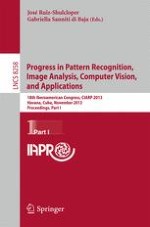2013 | Buch
Progress in Pattern Recognition, Image Analysis, Computer Vision, and Applications
18th Iberoamerican Congress, CIARP 2013, Havana, Cuba, November 20-23, 2013, Proceedings, Part I
herausgegeben von: José Ruiz-Shulcloper, Gabriella Sanniti di Baja
Verlag: Springer Berlin Heidelberg
Buchreihe : Lecture Notes in Computer Science
